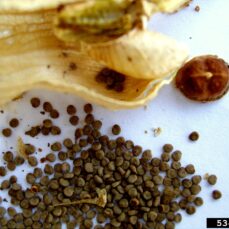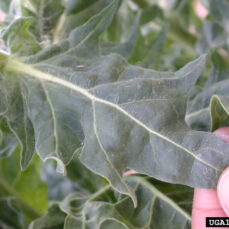
J. Samanek, State Phytosanitary Administration, Bugwood.org

Management Category
Squamish
Whistler
Pemberton
Vectors of Spread
ID Characteristics
General: Black henbane is an annual or biennial herb from the potato family (Solanaceae). The entire plant is covered in sticky, greasy hairs.
Flowers: Pale, yellow-green with purple veins and a purple throat. Each flower is funnel-shaped with five-lobed petals. Flowers produce an unpleasant smell.
Stems: Erect, woody stem that can grow up to 1 m tall.
Leaves: Hairy, dull green-grayish leaves that grow in an alternate arrangement along the stem. Leaves are partially lobed with conspicuous veins. Black henbane leaves produce an unpleasant smell and grow up to 15 cm wide and 20 cm long.
Seeds: Small, black seeds.
Roots: Thick, cylindrical taproot.
Similar Species
Exotic

Malta Wild Plants
White henbane (Hyoscyamus albus) can be distinguished by the pale-yellow color of the flower with a lack of a purple throat, and its stalked leaves. White henbane is exotic to BC and native to North Africa, Southern Europe, West Asia and Macaronesia.
Habitat and Origin
Black henbane originates from the Mediterranean and has been used as a medicinal plant since the Middle Ages. In the past, it has also been used in religious rites for its hallucinogenic properties.
Black henbane is now predominately cultivated for bird feed in parts of Asia, North Africa and Europe.
Black henbane grows in areas with moist, nutrient-rich, sandy or loamy soils. It can be found in disturbed areas such as open rangelands, roadsides, and riparian areas. Black henbane does not tolerate shade or saturated soils.
How it Spreads
Black henbane reproduces solely by seed. A single plant can produce up to 10,000 seeds in one season, which can remain viable in the soil for up to five years.
Black henbane seedlings are more likely to establish in disturbed or cultivated areas, as the seedlings are not very competitive in well-established plant communities.
Seeds can be spread by wind and by contaminated soil and gravel. Gardeners also contribute to the spread of black henbane by planting it in their gardens.
Impacts
Health
- Warning: extremely toxic to livestock and humans.
Ecological
- If allowed to establish, black henbane can form monocultures that suppress native plant communities.
Economic
- Harbours major crop pests, which are detrimental to the farming industry.
Stop the Spread
Black henbane is NOT currently found in the Sea to Sky Corridor, so the best approach to controlling its spread is by PREVENTION.
This is a high-priority invasive species for the Province of BC, and it is included in the Early Detection and Rapid Response (EDRR) program.
If you see black henbane, please report it.
B.C. Distribution
Black Henbane Factsheet
Having trouble viewing the factsheet? Don’t worry, all the information is included on this page. You can also contact us with any questions.
Additional Resources
References
- Alberta Invasive Species Council, Black Henbane
- CABI Compendium on Invasive Species, Hyoscyamus niger (black henbane)
- Electronic Atlas of the Flora of BC, Hyoscyamus niger
- Fraser Valley Invasive Species Society, Black Henbane
- Global Biodiversity Information Facility, Hyoscyamus niger L.
- Government of BC, Black Henbane Alert Factsheet
- Okanagan Invasive Species Online, Black henbane
- Washington State Noxious Weed Control Board, Black Henbane

















